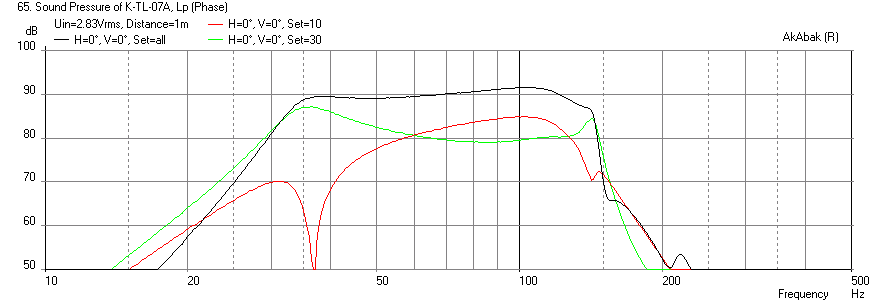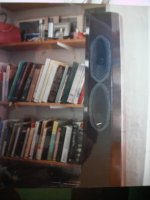Спасибо, буду делать Karlsonator 8
"Thank you, I will make..." 😉
Let us know how it goes and post some pictures! The Karlsonator 8 might be fun with some vintage Russian drivers such as LOMO, keep an eye out for these to try for kicks.
IG
Please tell me how important it is, if the size of the inside front is 11.8", not 12". I feel so comfortable making of the finished sheet of plywood. How to insert a photo?
Please tell me how important it is, if the size of the inside front is 11.8", not 12". I feel so comfortable making of the finished sheet of plywood. How to insert a photo?
.2" is unlikely to make any audible difference. Don't worry about it.
You can't upload pictures directly. You'll need to post them on some free picture hosting site. When posting to the forum, paste the URL link into your post using the little picture icon in the tool bar.
Last edited:
I have a BK-20 with Fostex 206EN. Will F206EN play better in KARLSONATOR?
That you will need to decide for yourself. It will sound different, and I suspect it will sound a little mellower and less bright.
Freddy has had the FE206EN in the BK20 as well as several Karlsons. Perhaps he will comment.
Actually we can upload images here, at least it seems to have been so for a year or two, not sure. I remember not being able to before at least.
IG
IG
Hi yyyrik,
When you "Reply to Thread" scroll on down to "Additional Options". There you'll find "Attach Files", note the valid file extensions, and click on "Manage Attachments" this will allow you to uplode files from your computer.
Regards,
When you "Reply to Thread" scroll on down to "Additional Options". There you'll find "Attach Files", note the valid file extensions, and click on "Manage Attachments" this will allow you to uplode files from your computer.
Regards,
"Я думаю, что в 206EN K12 было бы больше "воздействие", чем BK20"
Freddy, Karlsonator or K12? What better?
Freddy, Karlsonator or K12? What better?
With the Karlsonator, you can expect deeper bass extension, to about 50Hz, and generally smoother frequency response overall. The old Karlson original K8 designs tended to be very small, and had very limited bass extension. The Karlsonator was an attempt to come up with a design that met 'modern' expectations as to bass extension and had a smoother less rocky response, while still retaining the strong points of Karlsons with regard to good dispersion, low distortion, and subjective 'punch'. Obviously, since it's my design, I like this one. 😉
RE the K12: I 'heard' the K12/FE206EN combination on youtube, and from what I could tell it sounded great. Frankly it surprised me a bit. It has a larger front chamber volume. This is going to have more gain in the ~90-200Hz bandwidth, and not go as deep - I think. (it was never measured). I'd expect a rockier graph also. This may provide perhaps a livelier, 'pro speaker' type of sound.
I'm sure Freddy will respond shortly.
RE the K12: I 'heard' the K12/FE206EN combination on youtube, and from what I could tell it sounded great. Frankly it surprised me a bit. It has a larger front chamber volume. This is going to have more gain in the ~90-200Hz bandwidth, and not go as deep - I think. (it was never measured). I'd expect a rockier graph also. This may provide perhaps a livelier, 'pro speaker' type of sound.
I'm sure Freddy will respond shortly.
I don't have data on the Karlsonette/K12 other than a comparison of the Karlsonette and my "XK8" with the Tangband 1772. That showed 2dB->5dB more output with the Karlsonettte/K12 than the narrow K-coupler. If I remember correctly. both cabinets with 1772 had similar low frequency graphs. My graphs were done indoors and room modes were evident.
When comparing two venting methods in the 13.5" wide by 28" tall by 14" deep Karlsonator8 prototype, Greg B's method had the advantage but I think it had lower tuning (I did not make the graph below)
the Karlsonator8 prototype was 1.5" less in depth than the plan - my carpenter friend is cheap with materials 😀
there is a lot of flexibility in making Karlson-type couplers - they can work well and sound very good.
either cabinet should be worthwhile with FE206EN
front of test coupler
Yellow = Karlsonator path venting
Green = XK8 vent
XK8 as built with lower vent position
When comparing two venting methods in the 13.5" wide by 28" tall by 14" deep Karlsonator8 prototype, Greg B's method had the advantage but I think it had lower tuning (I did not make the graph below)
the Karlsonator8 prototype was 1.5" less in depth than the plan - my carpenter friend is cheap with materials 😀
there is a lot of flexibility in making Karlson-type couplers - they can work well and sound very good.
either cabinet should be worthwhile with FE206EN
An externally hosted image should be here but it was not working when we last tested it.
An externally hosted image should be here but it was not working when we last tested it.
front of test coupler
An externally hosted image should be here but it was not working when we last tested it.
Yellow = Karlsonator path venting
Green = XK8 vent
An externally hosted image should be here but it was not working when we last tested it.
XK8 as built with lower vent position
An externally hosted image should be here but it was not working when we last tested it.
Last edited:
I recently found that if I get rid of the Karlson aperture and make a rectangular opening over the exit where the drivers are, you get a tapped horn. As such, the Karlsonator actually can have some pretty good duties as a sub woofer. Here is a 34 in tall x 7 in wide unit with dual 5.25 in Tang Band woofers. There is enough room to flip one of them around in push pull config to reduce distortion. Here is example with 37 Hz high pass filter and 150 Hz low pass filter applied.


Which segs into a thought, I've been having. I've been reading about Karlson speakers for the last few months. The part of his tech that I think I understand most clearly is the aperture. So what if a clam is made with a tapped horn slot at the bottom of the aperture cavity, right below the cone face. Has this been done, and were the results any good?
Don't understand what you mean with a Klam. A Klam has no TL for a tapped horn action. There is the Metro T15 subwoofer that uses a K aperture.
Obviously a clam with a tapped horn line behind the speaker. Would be large, I think, but then there are some mentions of longer clams in the literature (without the TL line behind the speaker) of clams with noses up to 1.8 meters long, I guess trying to get a clam to be anything but a midrange sound projector.
here's a picture - probably 20 years back of a klam subwoofer built by Wayne Neuser - think it was a 10" and employed a tunable passive radiator. The aperture was linear as it only covered bass - the little klam-sub augmented a total of 8-10" Scanspeak in aperiodic boxes. According to Carl it was pretty punchy, and the K-loading reduced the PR's excursion.
An externally hosted image should be here but it was not working when we last tested it.
hey XRK971 - how would you go about choosing driver and klam chamber sizes for a passive radiator Klam-woofer/sub? Carl with their 10" driver sub-above said they used a 12" passive radiator and to try to avoid adding any weight. I get the idea it would look like a T15 but with PR facing up in place of the vent. The little klam sub above must have been decent to successfully augment 8-10" Scanspeak woofers. (Carl said is was punchy and had explosive power - I'll have to ask what they used for a woofer) Also, other than height, would a conventional Karlson shape with passive radiator be about as useful as the klam-sub? - the upper board would have to be long enough to fit say a 12" Dayton passive radiator for a 10" woofer.
can you modify the T15 model for PR without undue headache? - or would a PR-klam require starting from scratch to keep everything in order?
can you modify the T15 model for PR without undue headache? - or would a PR-klam require starting from scratch to keep everything in order?
Last edited:
Freddi,
A PR can be added easily as it is 2 lines of script. The question is should I keep the internal vent tube's geometry as it acts like a divider chamber wall? Easy to keep it and replace open duct port with PR.
A PR can be added easily as it is 2 lines of script. The question is should I keep the internal vent tube's geometry as it acts like a divider chamber wall? Easy to keep it and replace open duct port with PR.
- Home
- Loudspeakers
- Full Range
- Karlsonator
